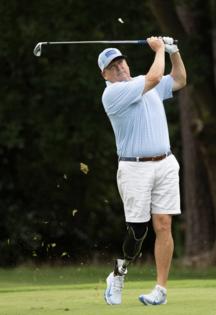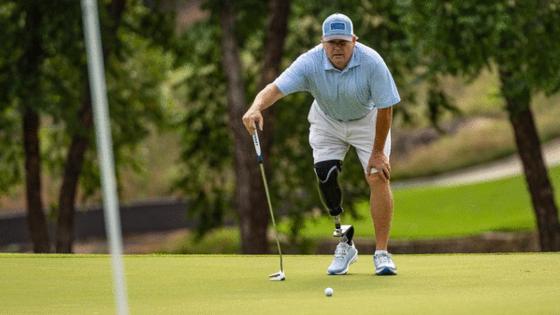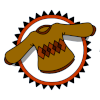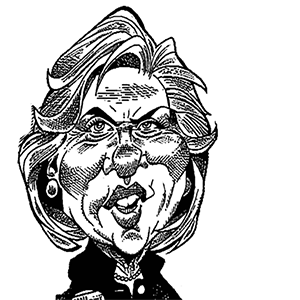Luke DeCock: A return to competitive golf helped Garrett Smyth find balance after amputation
Published in Golf
RALEIGH, N.C. — His swing is as smooth as ever, the one that was good enough to get him on the golf team at Furman and chase a professional career after college. At age 55, Garrett Smyth can still pop it out there 280 yards off the tee when pressed, and 260 regularly.
He has, however, had to adopt a new swing thought, the last thing that goes through his mind before he takes the club back.
“Don’t fall down,” Smyth said.
And that’s no joke, because maintaining his balance on a prosthetic right ankle and foot isn’t easy, as easy as he makes it look. In golf and in life, that’s his new mantra.
A four-time bone cancer survivor who had an amputation below the right knee in October 2023, Smyth qualified for his first U.S. Adaptive Open this week in Rockville, Md. Earlier this year, he was at Woodmont Country Club for his day job, installing management software for Clubessential. He told the client he’d be back in July. That drew a double take until he lifted up the right leg of his pants.
As a younger man, Smyth twice tried to make a go of it on the minitours, golf’s most difficult path. He worked in the restaurant business in Hilton Head. He worked as a teaching pro, including at Carolina Country Club in Raleigh 25 years ago; now he’s a member there.
Eventually, he got married and settled in Raleigh, his wife Katy’s hometown. They had two sons and he got into the software business. Work and family and coaching his boys in baseball replaced competitive golf, until the cancer came back a fourth time and amputation was the only option.
Suddenly, he had everything to prove on the golf course.
“This is what drives me,” Smyth said. “Maybe it was because I’ve gone through some down moments when I had the bone cancer diagnosis. Gone through those moments where I sat on the couch and cried by myself, ‘Why did this happen to me?’ Maybe because I’ve gone through those moments, I just decided I’m not going through that. I’m going to keep moving forward. I’m going to go play tournaments.”
Essentially a scratch golfer maintaining a 1.8 handicap index, he even qualified for the North Carolina Senior Amateur in Salisbury in May and finished tied for 37th against his two-footed peers, in part because he faded over the final nine holes having not played three straight days of golf in ages, let alone on a prosthesis for the first time.
That was his first real tournament in 17 years. Two months later, he’s playing in a national championship on the Golf Channel.
Chasing a dream
The fourth Adaptive Open began Tuesday. The first two were played in North Carolina, on Pinehurst’s No. 6 course, and without actually being present, it’s impossible to understand the gravity of the event. It’s a celebration of persistence and talent, with inspiration everywhere you turn. It took a while for the USGA to start hosting an adaptive championship, but it has since fit neatly into the golf calendar, just like any of the others.
As a teaching pro in his native Tennessee two decades ago, Smyth worked briefly with Jordan Thomas, who had a double lower-leg amputation after a boating accident. Now they’ll compete against each other this week. Fayetteville’s Eli Villanueva, who suffered an elbow injury as an Army paratrooper, is a contender in the upper limb impairment category. There are seated golfers and amputees and golfers with intellectual and vision and coordination impairments, all playing golf at an incredibly high level.
It’s not a tournament that Smyth had ever envisioned competing in, but life had a different plan. He grew up trying to keep up with his two much older brothers, playing golf and baseball. There wasn’t a big junior golf circuit there, then; instead, his dad would hand him a $20 bill, drop him off at one of Chattanooga’s big gambling games, and tell him not to lose it.
That got him to Furman, where he first met Ted Kiegiel, now the longtime director of golf at Carolina, teacher of Webb Simpson, the late Grayson Murray and many other local stars, but back then an assistant pro at Augusta National. One of Smyth’s teammates was the son of an Augusta pro. In May, when the members were all gone, they’d go down there and play. During the Masters, they’d work in the merchandise tent, before that became the multi-million dollar enterprise it is today. Smyth was in charge of hats.
Smyth and Kiegiel had a natural rapport, the kind where Kiegiel could watch Smyth for 10 minutes on the practice tee, make one crucial adjustment, and leave. When Smyth had taken his pro career as far as it could go after college, he joined Kiegiel’s staff at Carolina for five years. Smyth watched Kiegiel teach for six months before giving his first lesson.
“He was a really exceptional player, super-gifted,” Kiegiel said. “A complete game — really good off the tee, great iron player, great short game. All of them when they’re playing college golf have an ambition to play professionally and that was on Garrett’s radar. As he continued to progress, finishing school and looking at career paths, he and I had become such good friends at Augusta and then by happenstance I had an opening on staff here at Carolina. So we got to work together here as part of our pro team for a number of years, and near the end of that tenure raised enough money to go play professionally again.”
Smyth first met his future wife while he was working at Carolina, although it would be a long time before they got together. There was still another golf dream to chase, another spin through the minitours. The first time around, he qualified for one event on what is now the Korn Ferry Tour, one step below the PGA Tour, in 1994. The second time around, he made it through a U.S. Open local qualifier to final qualifying at East Lake in Atlanta in 2001, 13 shots short of a spot in the Open after 36 holes. But the grind is hard, the rewards thin and the path to the PGA Tour steep.
Smyth eventually took a job as an assistant pro back home at a Chattanooga club, and he played in a few Tennessee PGA events while teaching there. When he moved to Raleigh in 2010, got into the software business and got married, he knew his tournament golf days were over. That was in his past.
Four diagnoses
Smyth was diagnosed with chondrosarcoma for the first time in 2006. Back then, it was considered a benign tumor. It’s more common in the shoulder or hip; Smyth says fewer than 10 Americans are diagnosed with it in their ankles each year. The first tumor was the size of a tennis ball. The second, two years later, was the size of a grape. Each time, more bone came out of his right ankle.
When it came back for the third time 10 years ago, his options had narrowed. To avoid amputation, he underwent a bone graft to reconnect his tibia and ankle that required him to spend 18 months on crutches and three years in a walking boot, living with the constant fear that one wrong step could unravel months of healing.
His boys, now 13 and 11, were old enough to understand when the chondrosarcoma came back for the fourth time in 2023. It’s a slow-growing tumor, and Smyth had time to plan ahead before the surgery. His youngest son didn’t say anything about it for months, until one day in the car when the questions spilled out, one after another.
Smyth was walking on his new prosthetic two days after it was fit, against his doctor’s advice. He worked with Kiegiel to modify and fine-tune his swing, although the easy, shifting motion he’d always used made it simpler than it might have been otherwise. The phantom sensation in his right foot — “I can feel my big toe tingling right now; I know exactly where it is” Smyth said at one point, after taking off his prosthetic and placing it next to his chair — helped him maintain his balance. His first round on one foot, he shot 82. He was back under 80 in a matter of weeks, with a new sense of purpose to his game.
“I had a front-row seat to all that,” Kiegiel said. “We discussed it every step of the way. Ultimately, on the other side of the procedure, he was re-learning how to walk, how to move, how to stay balanced. Things everybody takes for granted. Going up and down stairs. Parking a car. Getting in a car. Everything it takes to navigate it back to the golf component. And then essentially he had to re-learn how to play the game.
“You’re talking about somebody who was a very talented player, but instead of a biped, you’ve got one ‘ped’ under you, one supportive leg essentially there for balance. The dynamics of how the swing shape functions, how the club bottoms out, rotary movement — all of that has to be modified. He was diligent and pushed forward through it. And sure enough, he set up these goals for himself that he wants to play competitively and have that ambition, which I’m super-supportive of.”
Smyth had been fighting against amputation for years, dreading it, only to find that it unlocked a drive in him he’d long ago suppressed — and that compared to three years in a walking boot, anything was easier.
His wife and his prosthetist, Marco Calcagno of LimBionics, encouraged him to start a YouTube channel and Instagram account to document his new adaptive career, called Defy Your Handicap. The concept is to be a positive role model for others in the same situation, to show how smooth his transition has been without sugar-coating it, offering tips and tricks he’s learned along the way..
“I want to be careful,” Smyth said. “I don’t want to be like, look how easy it is for me. I don’t want to do that. I can share some struggles. I just had to withdraw from a tournament because I had something pop up on my leg. That’s what we go through.”
One unexpected fringe benefit of his social-media efforts: The exposure led the medical-device company Ottobock to send him the high-tech athletic prosthesis he uses now, a carbon-fiber blade called a Challenger that fits into a regular shoe. With that, he can get anywhere on just about any golf course short of the most extreme Pete Dye-style architecture. He can swing more or less like he always did. He can play almost like he never stopped.
Finding balance
As easy as Smyth is making this look, there’s a lot of struggle and hard work behind the curtain. After an amputation, the remaining limb tends to shrink over about a two-year period. Smyth is on the second socket that attaches his leg to the prosthesis, and is almost ready for a third. During a round of golf, he has to add two or three additional padded socks between his leg and the socket just to keep his leg aligned. Blisters are a constant plague.
He wanted to qualify for the Adaptive Open last year, but it was too much to ask. Even this year, when he shot 4-over and finished third at an April qualifier in Winder, Ga., he wasn’t sure it would be good enough to get him in. But he was the top men’s finisher in the lower-limb impairment category, and ended up making the field.
Last week, he was supposed to go to Wilmington to qualify for the U.S. Senior Amateur, but had to withdraw when a cyst developed on the back of his knee. It’s healing now, but since then he has played only 12 holes leading up to his scheduled practice round at Woodmont on Sunday, and he’ll play it by ear whether he goes a full 18 then.
“I’m learning,” Smyth said. “I’m learning about this. I’m learning about the socks. I’m learning about what my body is going to do. I’m learning how to stay a little bit more balanced.”
But as hardships go, that’s pretty minor. After dropping his kids off at summer camp in Chattanooga, he drove back to pick up his wife and drive up to Maryland. It’s the first time she’ll ever see him play a tournament round. It’s hard to have expectations. For someone who has spent a lifetime playing golf, this is all new to him.
If everything goes right, if his leg holds up OK, maybe top 20? It’s difficult to say. But the real goal hasn’t changed: Don’t fall down.
“The state of my game is, I’m a dad first,” Smyth said. “I know what it takes to get really, really sharp. I’m probably not going to do it. I have a little bit more of a desire to be better because this happened. Before that, it wasn’t so much. The best job I have is being a husband and father first. That’s where the balance comes from.”
____
©2025 The News & Observer. Visit at newsobserver.com. Distributed at Tribune Content Agency, LLC.










Comments